Dell XPS 14z: Thoroughly Reviewed
by Jarred Walton on October 24, 2011 9:00 AM ESTThe Screen: A Crying Shame
We’ve seen so many blasé laptop displays over the years that it’s hardly noteworthy anymore, but with the XPS 15 and XPS 15z offering good quality 1080p panels, not to mention the Alienware M14x, M17x, and M18x (the M11x being notably absent), we were hoping for a pleasant surprise. Unfortunately, like the defunct XPS 14 L401x, the XPS 14z is packing a decidedly mediocre LCD panel—and there’s no current option for an upgraded panel.





In order of importance, maximum brightness and contrast are the first two areas where we like to see good results. Looking at our global database of laptop displays, only the top third (often in high-end laptops costing $2000 or more) even manage a 500:1 contrast ratio, which is the bare minimum we’d like to see. Likewise, only the top 20% or so manage at least 300 nits maximum brightness. The panel in the 14z ranks in the bottom third for brightness and the bottom 20% for contrast. Not surprisingly, color gamut is also very low, at just 38% of AdobeRGB—that’s the fourth lowest gamut we’ve measured in nearly two years. Given those results, the color accuracy is almost meaningless, though it also rates in the bottom third.
The viewing angles of the LCD don’t help the situation. From head on, the display looks fine, and we still like the thin left and right bezels. However, off angle viewing is highly prone to color shift, and vertical viewing angles need to be within about a 10 degree arc to be useful. Compare the viewing angles with the Dell XPS 15z and you’ll see why we desperately want the option for an upgraded LCD panel—a 1440x900 display would be ideal.
















60 Comments
View All Comments
hechacker1 - Monday, October 24, 2011 - link
Apple's reputation I think is exaggerated because they take the time to factory color calibrate the screens. I don't think any other PC manufacturer does the same.But even Apple's factory calibration lately has tended toward the cooler 6800K temperatures instead of an ideal 6500K for web browsing or watching videos. They are playing into the fact that people tend to like the ultra bright, cool balanced screens that make them seen "bright and white" when comparing them side by side.
Looking at past Anandtech reviews, it's clear the Macbook's generally have very high quality screens brightness, color quality, and contrast wise.
Sure they are lacking in resolution on the laptops, but OS-X isn't resolution independent yet.
kishorshack - Monday, October 24, 2011 - link
Go for DELL XPS 15 it has an awesome screenI can look at it for ages :)
MobiusStrip - Tuesday, October 25, 2011 - link
"This is one area where I applaud Apple, they provide high quality, high-res (16:10 in some cases!) screens."Rendered garbage by Apple's insistence on shoving pathetic glossy screens down customers' throats.
Oh, you can pay $150 extra for matte on the biggest MBPs, but you can't get it on the machines most likely to leave the house: the 13" MBP or the Airs.
Glossy screens are the biggest regression in computers ever. Yet manufacturers just get a free pass on this fraud.
Stuka87 - Monday, October 24, 2011 - link
So I like the small bezel around the screen. Its about time somebody did this (if somebody else has, I apologize for not knowing). This is one of the things that I really dislike about my Precision M4600. They could have easily fit a larger 16:10 display.Its a shame the quality of the display in the 14z is so poor. The rest of it seems to be a fairly decent design.
tipoo - Monday, October 24, 2011 - link
I really wish they kept that 525M in there like the 15", the 520 is about half as fast. In fact, its not far from the HD3000.Death666Angel - Monday, October 24, 2011 - link
"I’m not sure why they include only one SS port, given the second USB port is right next to it."Not sure if this applies here, but I couldn't install Windows 7 from my USB stick on my Llano system with an AsRock A75M-ITX and A6-3500 CPU. It just didn't recognize the stick. In the USB 2.0 ports there was no problem. I guess it's driver issues. If that is the case, I can see why they want to keep at least one USB 2.0 port available.
If that is not the case and USB 3.0 makes no problems when installing from media attached to it, then disregard this post. :-)
dagamer34 - Monday, October 24, 2011 - link
Well, Windows 7 doesn't natively have USB 3.0 drivers included on the disk, so it's going to be confused by the chipset connected to that port. Should be fixed in Windows 8 though (it has native Windows 8 support).dagamer34 - Monday, October 24, 2011 - link
Ooops, I meant native USB 3.0 support.hechacker1 - Monday, October 24, 2011 - link
Isn't it backwards compatible though? The bios might have an option to run it in HiSpeed mode or whatever if it can't be detected as USB3.0 without a driver.jpochedl - Tuesday, October 25, 2011 - link
USB3.0 can run at USB2.0 speeds, but the WinPE environment still needs a driver that supports the USB3.0 chipset in order to access the USB3.0 port....